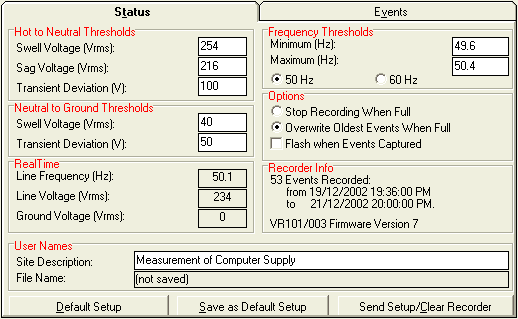|
Fluke's plug-in Voltage Event Recorder - VR101
A fully configurable voltage event recorder (as opposed to a voltage recorder) that is designed to measure the extent and duration of voltage anomalies that exceed preset parameters. Sags and swells are programmed and read in 2V steps. This makes the resolution accuracy just under 1% on 230V systems and just under 2% on 110V systems. It also has the ability to detect sharp transients on both Live-Neutral, and Neutral-Earth. This is handy for ensuring solid Neutral-Earth connections in TNS and TNC-S systems. These are programmable in 10V steps, L-N starting at 100V, and N-E at 50V. Although transient duration is not available, the peak voltage and polarity, and the point on the cycle at which it occured, is. One handy feature, if testing the outputs of UPSs or generators, is an 'out-of-frequency-range' event log. I cannot truly think of any other reason this would be useful. If the country's frequency is out of spec, one cannot exactly phone the national reticulation control centre and have them drop the load to give the generators a break! What would have been a lot more handy would have been a "rate of change of frequency" output as these are known to affect many UPSs - with indications of either a sudden phase shift of either positive-going or negative-going zero crossings. Connection to the PC is done through an optically isolated 'wand' that slots into the front of the unit - no risk of blowing up your precious laptop. The wand is extremely well designed (electronically speaking) and operates without error at 19200 Baud over a 20 metre com port extension cable (most modern com ports do not like operating over this length of cable). The software also has no problem working over an economical USB to RS232 convertor. While connected, one can read the Line and N-E voltages, and the frequency. Data is downloaded as soon as 'connection' is made, and the software (fully operational on all Windows platforms, including XP) is truly extremely easy to operate. One can see that some thought has been put into the software allowing the lamp to not show when an event has occured. Such a feature could have the poor investigator being bugged by an overzealous client everytime the unit blinked! But having said this, I am a little surprised that no attempt has been made to collect a trend of the voltage, even if just an average. This does leave a little bit of interpreting of the results to be done, and could lead to more puzzles created than what are solved. I believe that effort could be put into splitting the multiple transients to allow displaying of all transient events (it only allows single transient events to be viewed), or at least the display of the most severe transient event. However, as a first-line instrument, one really could not do better, except maybe the price.
© 26.01.03 |
 MEASUREMENT TECHNIQUES:
MEASUREMENT TECHNIQUES: